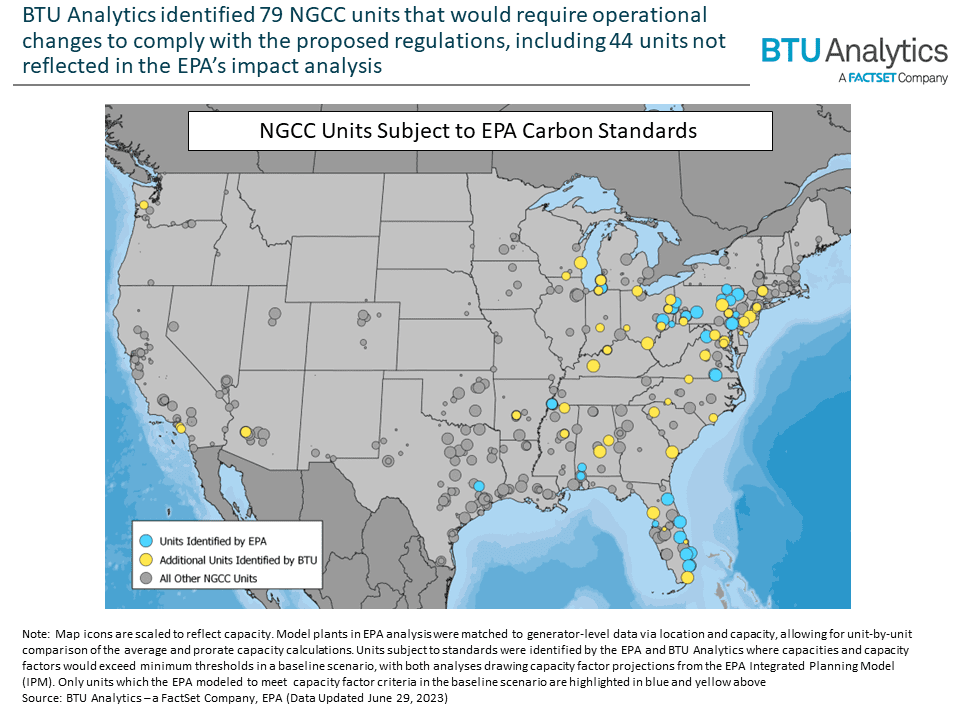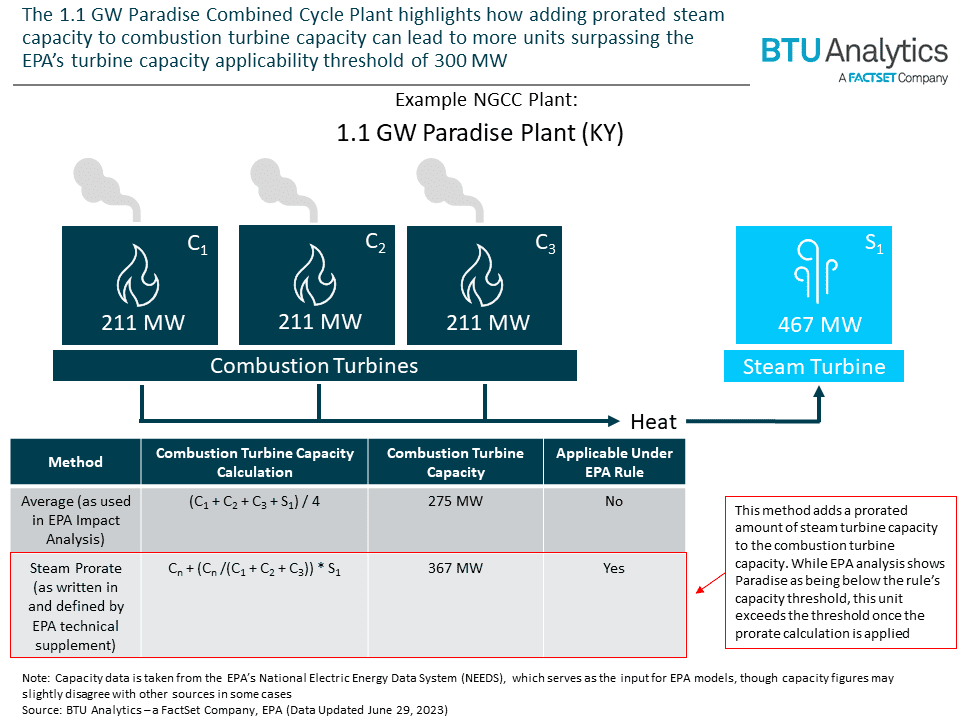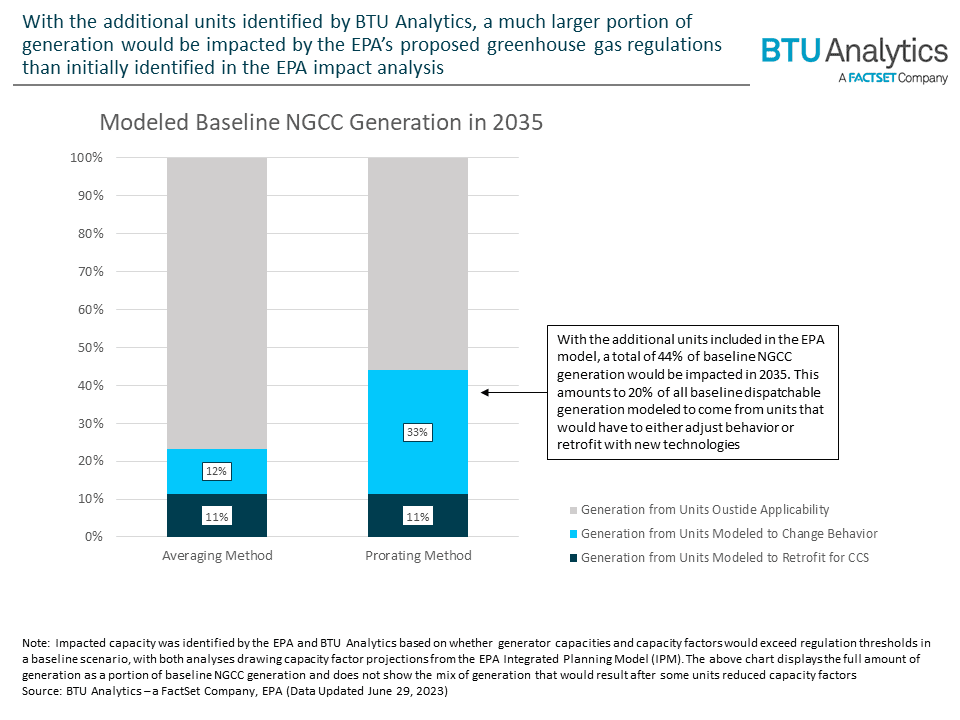Emissions Rules Could Target More Gas-Fired Power Plants
Much of the discussion after the U.S. Environmental Protection Agency (EPA) earlier this year issued new emissions standards for power generation units focused on the impact for coal-fired power plants. The rule in effect would require most fossil fuel-burning power plants to reduce their greenhouse gas (GHG) pollution 90% between 2035 and 2040.
Energy industry experts said the new rules likely would move utilities to fast-track decisions to close older coal-fired plants, as many already have done, rather than installing technology that could limit emissions.
An analysis from a Colorado-based group, though, finds the EPA’s carbon standards could have a much greater effect on natural gas-fired generation than previously thought. Analysts with BTU Analytics, a FactSet Company, using recently published EPA regulatory guidance, found twice as much gas-fired capacity could be impacted compared to original expectations.
79 Gas-Fired Units Affected
The report was written by Jonathan Crawford, a senior research analyst with BTU who specializes in carbon markets. The analysis was done by BTU Analytics’ Energy Transition team, including Crawford, Carolyn Nuyen, and Nick Jones. The report said at least 79 gas-fired units, representing 72.5 GW and 44% of modeled baseline natural gas combined cycle (NGCC) generation, would meet the EPA’s proposed enforcement criteria once a prorating methodology is applied in calculating turbine capacity.
The EPA’s draft rule, issued in May, said natural gas-fired combustion turbines, including NGCC units, with generating capacities above 300 MW and utilization rates exceeding 50% would face strict emissions limits. Operators would need to install carbon capture and sequestration (CCS) technology, or reduce a unit’s utilization rate to 50% or lower, to avoid the emissions standards. The regulations also said NGCC units could co-fire with a mixture of natural gas and hydrogen, which would reduce emissions, but the EPA’s impact analysis issued in May did not offer that option for existing NGCC units.
The EPA said the standards are technology-based, including:
- Strengthening the current New Source Performance Standards (NSPS) for newly built fossil fuel-fired stationary combustion turbines (generally natural gas-fired, as no new coal-fired plants are expected to be built in the U.S.).
- Establishing emission guidelines for states to follow in limiting carbon pollution from existing fossil fuel-fired steam generating EGUs (electric generating units, including coal, oil and natural gas-fired units.)
- Establishing emission guidelines for large, frequently used existing fossil fuel-fired stationary combustion turbines (generally natural gas-fired.)
The May analysis from EPA quantified the number of facilities that would meet the 300 MW or higher threshold by using an average of generator capacity for each combined cycle unit. The agency identified 36.8 GW of capacity that would likely be subject to the new regulation. BTU Analytics reached a comparable number using a similar methodology.
Changing the Calculation
The EPA, though, on June 12 issued updated guidance that changed the calculation. The agency said a turbine’s size is determined by taking the nameplate capacity of the combustion turbine, and adding a prorated amount of steam generating capacity connected to the combustion turbine.

That methodology means several more NGCC units top the 300-MW mark and are subject to the new emissions rules. BTU using the prorating methodology identified 44 additional NGCC units in the U.S. that were not part of EPA’s original impact analysis. The EPA did not immediately respond to a request for comment from POWER.
“The text of the rule itself doesn’t specify how turbine capacity should be calculated for the 300-MW capacity threshold,” Jones told POWER on July 19. “In the ‘Regulatory Impact Analysis’ released alongside the rule, the EPA identifies ‘model plants with average unit size greater than 300 MW’ as being affected.” Jones noted that in the context of the EPA’s impact analysis, and in their published model output, “unit” appears to mean “generator.”
“The EPA’s guidance on the ‘prorating’ methodology was issued in the ‘Applicability of Emission Guidelines to Existing Stationary Combustion Turbines: FAQs,’ which is dated June 12,” Jones said. “In this document, the prorating methodology is fully explained and examples are used to show how steam capacity should be added to combustion turbine capacity. This is the major difference and, as our analysis shows, the EPA’s original projection of impacts changes significantly once the prorating methodology is incorporated.”
Kentucky Plant Provides Example
BTU Analytics offered an example of how the prorated methodology affects a specific power plant. The group said the 1.1-GW Paradise Combined Cycle Plant in Kentucky, operated by the Tennessee Valley Authority (TVA) and a POWER Top Plant award winner in 2017, has three 211-MW combustion turbines and one 467-MW steam turbine. Using the methodology of averaging turbine capacity across all units, the Paradise plant comes in below the 300-MW threshold, at an average of 275 MW.

Adding a proportionate amount of capacity from the steam turbine to the total capacity of the combustion turbines, though, moves that number to 367 MW. That means the units are subject to the EPA’s emissions requirements.
TVA in a statement to POWER did not specifically address Paradise or any of its other natural gas-fired units, saying: “TVA is building the energy system of the future and takes a holistic approach to developing all potential resources and complies with all regulations for existing and future generating assets. We continually monitor regulations and ensure we have the appropriate generation mix to meet our environmental goals and consumers’ energy needs.”
Crawford told POWER, “As part of the standard rulemaking process, the EPA is soliciting comments on various aspects of the draft rule, which may lead to revisions in a final rule. The EPA’s official statement is that the rule will not affect resource adequacy since operators have the option to apply CCS or hydrogen blending if necessary to maintain reliability.”
Lowering Utilization Rates
EPA’s original impact analysis showed that 36.8 GW, or 13.4% of the NGCC fleet capacity, would need to change operations by 2035 to meet the proposed emissions standards. The EPA’s modeling showed most of the shift would come from reducing utilization rates to 50% or lower.

The analysis done by considering prorated capacities, and adding steam turbine capacity to combustion turbine capacity, brings the fleet capacity subject to regulation to about 26.5%, or 72.5 GW of U.S. gas-fired generation, according to BTU. The group said its analysis showed many of the units subject to the EPA’s new proposed rules are among the most-utilized in the U.S., and using the prorated capacity limit in the impact analysis means as much as 44% of the EPA’s projected generation from NGCC units in 2035 would be impacted by the emissions rules.
That means many more gas-fired power plant operators likely would need to adjust their operating strategies. BTU noted some units would likely install CCS to meet the emissions standards, but for many that might not be economic, leaving questions about how they would operate if needed for grid reliability.
“In any case, we expect that the proposed standards will face legal challenges and specific provisions, including applicability thresholds, are likely to be revised throughout the rulemaking process,” said Jones.
—Darrell Proctor is a senior associate editor for POWER (@POWERmagazine).